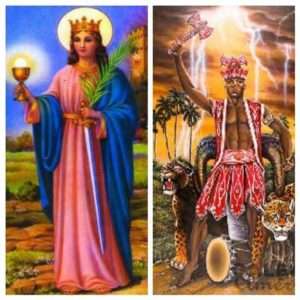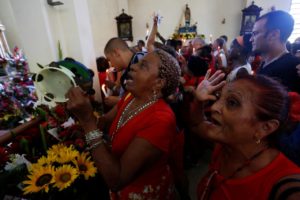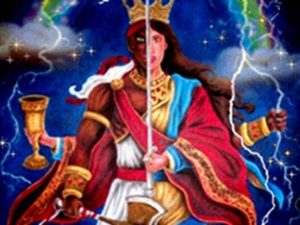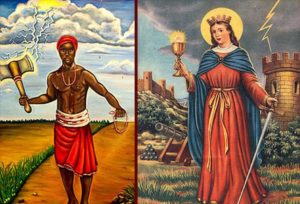 UNO SOLO, “SANTA BARBARA/ SHANGÓ”, SON ALABADOS EN CUBA POR MILES DE DEVOTOS.
UNO SOLO, “SANTA BARBARA/ SHANGÓ”, SON ALABADOS EN CUBA POR MILES DE DEVOTOS.
Para los santeros y cubanos en general Santa Barbara es Shangó. Ambos encarnan un enorme poder. Unos la ven como la venerable santa católica que fue decapitada a manos de su padre por defender su fe. Otros, como Shangó, uno de los orishas más populares del panteón que trajeron los esclavos africanos a la isla. De una u otra forma, es alabada fervorosamente por miles de devotos a lo largo y ancho del país.
Los primeros negros africanos traídos a Cuba adoraban a Shangó, considerado un emperador de infinito poder y dueño del oráculo, pero imposibilitados de rendirle tributo abiertamente, tuvieron que identificarlo con Santa Bárbara, una virgen en la que creían los miembros de la religión católica en el país.
Santa Bárbara, una virgen y mártir cristiana del siglo III, forma parte de la lista oficial del martirologio de la Iglesia Católica.
Para los católicos Santa Bárbara nació en el siglo III, en la Turquía asiática, con límites en el Mar Negro y a la edad de nueve años fue encerrada en una torre por su padre, quien quería protegerla de la vista de los hombres y del cristianismo, pero la joven dotada de gran inteligencia se percató de la falsedades de la doctrina pagana.
Ella logró entregarse a la fe cristiana y Dios la hizo santa, y entonces su progenitor enfurecido y temeroso de perder sus bienes materiales y privilegios otorgados por el Cesar, ordenó que la encarcelaran y la castigaran de forma cruel, y después el mismo la decapitó, pero ese día un rayo terminó también con su vida.
El hecho es que durante la etapa colonial la población negra de la isla era superior a la blanca y el homenaje cobró mayor significación, entre ellos, en detrimento del catolicismo, pero en la actualidad unos mantiene el rito a la deidad cristiana y otros se postran ante la excelsa y gallarda figura del Shangó.
Santa Bárbara aparece representa por una espada, con un paño de color rojo anudado al cuello y asimismo es poseedora del rayo y el trueno, y a ella se elevan las plegarias de los fieles ante las inclemencias del tiempo y con iguales atributos se reconoce a Shangó, un dios llegado desde África Occidental de la mano esclava.
Las fiestas de Santa Bárbara Bendita y el guemilere a Shangó, comienzan la noche del tres de diciembre y se extienden durante todo el día siguiente, al ritmo de los tambores, alrededor de un altar adornado con telas de color rojo oscuro, flores, velas y platos de harina de maíz, dulce de coco, plátanos maduros y verdes y golosinas.
Los alimentos son degustados por los presentes y una parte es reservada a la deidad, mientras el sonido de los tambores imprime un toque solemne a la ceremia que comienza con un canto dedicado a Elegba, catalogado como señor de los caminos y único que puede abrirlos o cerrarlos, según estime conveniente.
El ritual a Santa Bárbara, concluye con la entrada de Shangó, machete en mano , moviendose de un lado a otro del recinto, con ojos desorbitados y dientos apretados, como para imprimir mayor dureza a su rostro, y cuando dejan de sonar los de tambor se eleva la plegaria por Olofi, por Olodunmare, salud y suerte.
 ONLY ONE, “SANTA BARBARA/SHANGÓ”, ARE PRAISED IN CUBA BY THOUSANDS OF DEVOTES.
ONLY ONE, “SANTA BARBARA/SHANGÓ”, ARE PRAISED IN CUBA BY THOUSANDS OF DEVOTES.
For santeros and believing Cubans Santa Barbara is Shangó. Santa Barbara embodies a huge power. Some see her as the venerable Catholic saint who was beheaded at the hands of her father for defending her faith. Others, such as Shango, one of the most popular orishas in the pantheon brought by African slaves to the island. In one way or another, it is praised fervently by thousands of devotees throughout the country.
The first African blacks brought to Cuba worshiped Shango, considered an emperor of infinite power and owner of the oracle, but unable to pay tribute openly, had to identify him with Santa Barbara, a virgin believed by members of the Catholic religion in the country.
Saint Barbara, a virgin and Christian martyr of the third century, is part of the official list of the martyrology of the Catholic Church.
For Catholics, Santa Barbara was born in the third century, in Asian Turkey, with limits in the Black Sea and at the age of nine she was locked in a tower by her father, who wanted to protect her from the sight of men and Christianity, but the young woman endowed with great intelligence noticed the falsehoods of pagan doctrine.
She managed to surrender herself to the Christian faith and God made her holy, and then her enraged parent and fearful of losing her material assets and privileges granted by Caesar, ordered her to be jailed and cruelly punished, and then he beheaded her, but that day lightning also ended his life.
The fact is that during the colonial stage the black population of the island was superior to the white and the tribute took on greater significance, among them, to the detriment of Catholicism, but today some maintain the rite of the Christian deity and others prostrate before the excellent and gallarda figure of the Shango.
Santa Barbara appears represented by a sword, with a red cloth knotted around the neck and is also the owner of lightning and thunder, and to it the prayers of the faithful rise to the inclement weather and with equal attributes are recognized Shango, a god arrived from West Africa from the slave hand.
The festivities of Santa Bárbara Bendita and the Guemilere in Shangó, begin the night of December 3 and extend throughout the next day, to the rhythm of the drums, around an altar adorned with dark red cloth, flowers, candles and Cornmeal, coconut candy, ripe and green bananas and treats.
The food is tasted by those present and a part is reserved for the deity, while the sound of the drums prints a solemn touch to the ceremony that begins with a song dedicated to Elegba, listed as lord of the roads and only that can open them or Close them, as you see fit.
The ritual to Santa Barbara, concludes with the entrance of Shangó, machete in hand, moving from one side to the other of the enclosure, with exorbitant eyes and tight teeth, as if to print more hardness to his face, and when the drum stops the prayer is raised for Olofi, for Olodunmare, health, and luck.
Agencies/ Arrajatabla/ Alberto Denis/ Extractos/ Excerpts/ Internet Photos/ Arnoldo Varona/ www.TheCubanHistory.com
THE CUBAN HISTORY, HOLLYWOOD.










